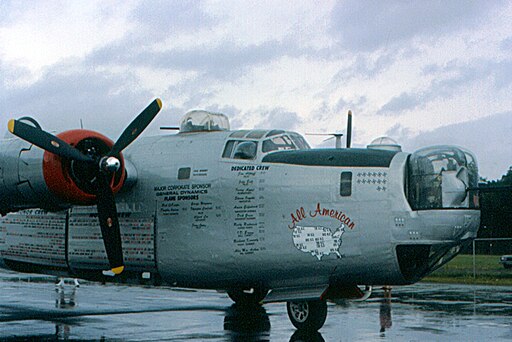The B-24 Liberator, a crucial asset in the Allied campaign during World War II, was ominously dubbed the “Flying Coffin” by its airmen. This foreboding nickname stemmed from the aircraft’s complex design, the grueling demands of its missions, and the harsh realities of wartime aviation. To grasp why this bomber, one of the most mass-produced aircraft of its era, garnered such a fearsome reputation, it’s necessary to examine its intricate engineering, trace its extensive operational history, and look carefully at the vivid firsthand accounts of the brave crew members who piloted it through the dangerous theaters of war.
A Design Geared for Efficiency, Not Comfort
The B-24 was designed to focus on efficiency and payload capacity, leading to certain compromises in its structural design and crew comfort. It featured a high aspect ratio Davis wing, which, while providing excellent lift and thus a heavier bomb load, resulted in a narrow and cramped fuselage. The interior was notoriously uncomfortable and challenging to move around in, especially at high altitudes where heavy, bulky flight suits were necessary.
Operational Vulnerabilities
The operational profile of the B-24 brought its own set of challenges. It required a long, unobstructed runway for takeoff, a luxury only sometimes available in forward airfields. Once airborne, the Liberator was less forgiving than its contemporaries, like the B-17 Flying Fortress. Its handling characteristics were often described as heavy, especially when fully loaded, making it a complex aircraft to pilot. These factors contributed to a higher accident rate during takeoff and landing phases, a critical consideration given the often less-than-ideal runway conditions.
Exposed to the Elements
The defensive armament of the B-24 was formidable but led to another significant issue: vulnerability to enemy fire. The placement of guns and the need for extensive ammunition storage meant that the aircraft could become a fire hazard quickly if hit. Moreover, the B-24’s fuel tanks, not equipped with self-sealing technology, were susceptible to catching fire from direct hits, which dramatically increased the risk of fatal explosions.
The Harsh Realities of War
Combat missions in the B-24 were grueling. The bomber crews were subjected to extreme cold, oxygen deprivation, and the constant threat of enemy interceptors and anti-aircraft fire. The psychological toll of these missions, coupled with the physical discomforts and perceived high vulnerability of the aircraft, contributed heavily to the nickname “Flying Coffin.”
Legacy and Recognition
Despite its notorious nickname, the contributions of the B-24 Liberator to the Allied war effort were immense. It was instrumental in several critical campaigns, including the bombing of German industrial facilities and the Battle of the Atlantic, where it helped curb the U-boat threat. The B-24 was also pivotal in the Pacific Theater, serving in anti-shipping roles and the bombing of Japanese-held territories.
The story of the B-24 Liberator is a stark reminder of the complexities and contradictions of wartime aviation. While the “Flying Coffin” nickname highlights the perilous nature of its missions, it also underscores the bravery and resilience of its crews. These men faced formidable dangers in the skies, their experiences a testament to the harsh realities of aerial combat. As we reflect on their service, the B-24 remains a symbol of not just the dangers they faced but their courage and sacrifice.
For more insights into the B-24 Liberator. and other important military aircraft, visit Aces In Action. Here, you’ll find an amazing piece of artwork by Craig Tinder titled “Crossing Through The Canyon,” which illustrates the crew of B-24H Liberator 41-28731 and the bomber crews of 392nd Bombardment Group (Heavy) from the United States 8th Air Force. The limited edition canvas print even includes a piece of the original remnant of the fuselage from B-24H Liberator s/n 41-28731, making it a unique piece of history!
Crossing Through The Canyon – B-24 Liberator Relic Aviation Art by Craig Tinder
31 May 1944 – 491 B-24 Liberator bombers took off from RAF Rackheath, England, aiming to strike rail targets in France and Belgium. Among them was Radio Operator Anthony V. Bell of the 467th Bombardment Group (Heavy), who described witnessing the most beautiful sight during the War: vast, white billowing clouds rising over 25,000 feet. While weaving through the canyon of clouds, the mission had to be aborted as the aircraft could not penetrate the thick cloud cover. Consequently, no bombs were dropped during this particular sortie.
To purchase or see similar items, visit here.Commissioned by Museums, Treasured by Collectors





Share:
Concorde: The Supersonic Marvel of Aviation History
Tirpitz and Bismarck: Unraveling Their Naval Tactics and Enduring Legacy